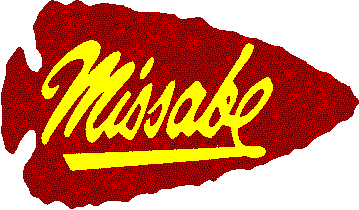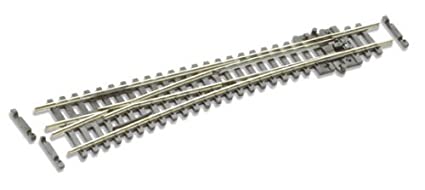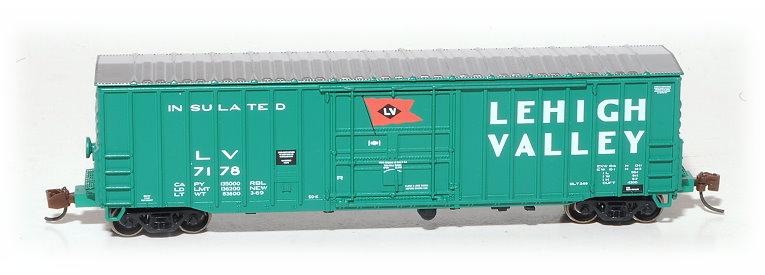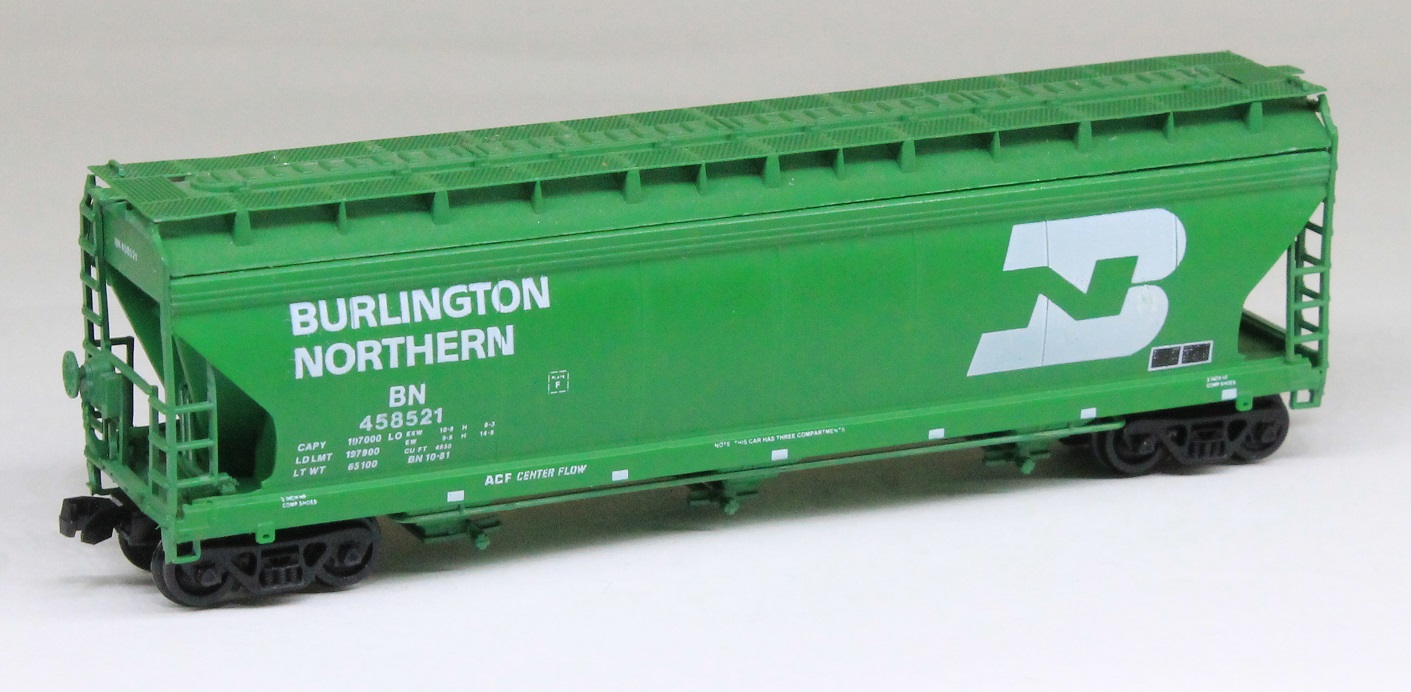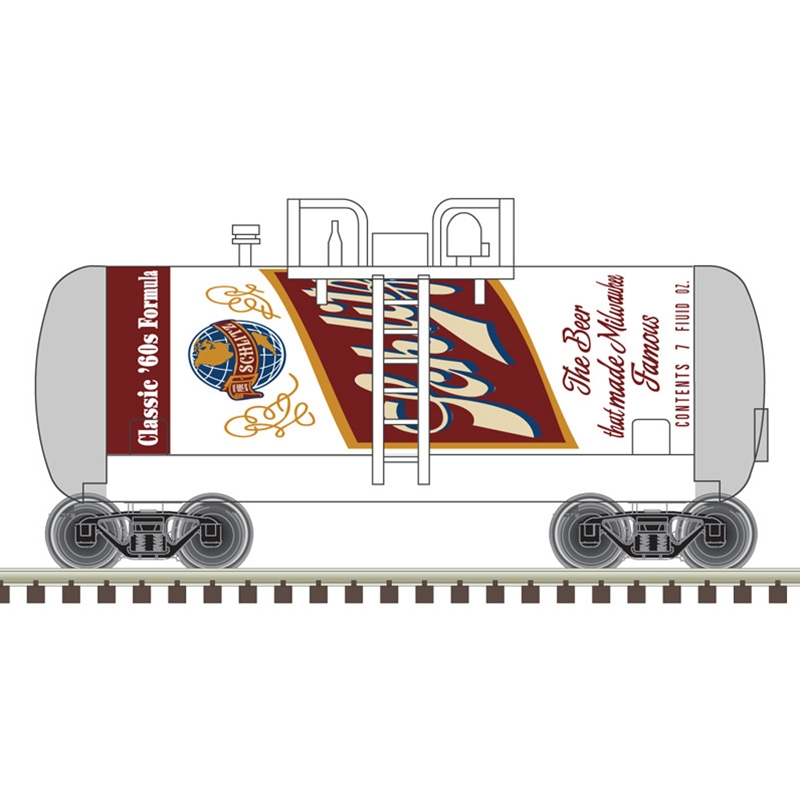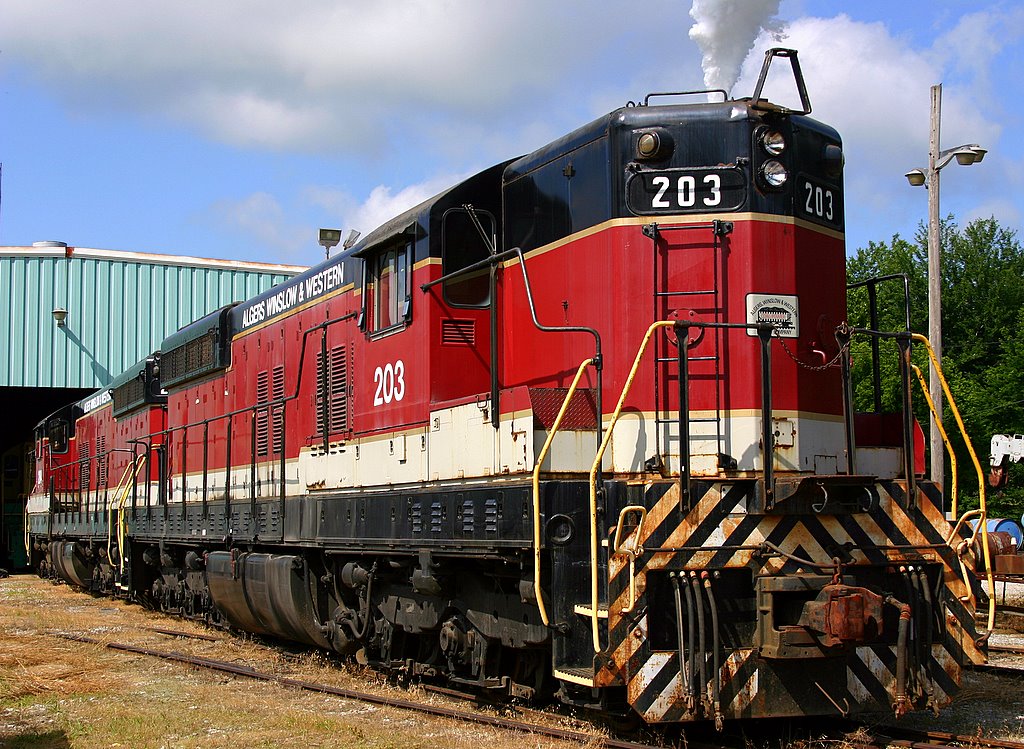Model Information: The model was introduced in 1990 and the early releases were made by Kato Japan for Atlas. From 2004 on, the models were made in China and the internals were modified to a more modern mechanism. The Atlas SD7, SD9, SD24 and SD26 all share the same internal mechanism and differ only in their shell details. The modern releases fall under the "Classic" label for the SD7 and SD9 models and "Master" label for the SD24 and SD 26.
The early releases featured the Kato-designed "low friction drive" which had been successfully introduced in their Kato-branded U30C model). This design allowed clean transfer of current from wheels to long copper strips to the chassis and then to the lightboard. This may not sound innovative, as many modern mechanisms use this design today, but in 1990 it was a game-changer. The post-2004 releases are fairly standard "modern" mechanisms featuring a split-frame, dual-flywheels, and magnetic operating knuckle couplers. They run quiet and smooth and can pull 30 or more standard-weight cars.
The early releases featured the Kato-designed "low friction drive" which had been successfully introduced in their Kato-branded U30C model). This design allowed clean transfer of current from wheels to long copper strips to the chassis and then to the lightboard. This may not sound innovative, as many modern mechanisms use this design today, but in 1990 it was a game-changer. The post-2004 releases are fairly standard "modern" mechanisms featuring a split-frame, dual-flywheels, and magnetic operating knuckle couplers. They run quiet and smooth and can pull 30 or more standard-weight cars.
DCC Information: Models produced from 2006 are DCC Ready or Dual-Model Decoder Equipped. They accept the following drop-in decoders:
- Digitrax DN163A0: 1 Amp N Scale Mobile Decoder for Atlas N-Scale GP40-2, U25B, SD35, Trainmaster, B23-7 and others
- TCS AMD4 (Installation for Atlas SD-9)
- NCE N12A0: Plug and play decoder for N-Scale Atlas GP40-2, U25B, U23B, B23-7, 30-7, 36-7, GP38, SD25, TRAINMASTER, etc.
- MRC 1812: N-Scale Sound Decoder for most Atlas short/medium locos (selection of 4 prime movers - might not be prototypical for this model however)
Earlier DCC factory-equipped versions were fitted with Lenz LE063XF decoders, whereas most recent versions are fitted with NCE N12A0 decoders. The Atlas version of these decoders will respond to manufacturer's address "127" (CV8) i.e. "Atlas Model Railroad Products", though being identical to their original manufacturer's specification.
- Digitrax DN163A0: 1 Amp N Scale Mobile Decoder for Atlas N-Scale GP40-2, U25B, SD35, Trainmaster, B23-7 and others
- TCS AMD4 (Installation for Atlas SD-9)
- NCE N12A0: Plug and play decoder for N-Scale Atlas GP40-2, U25B, U23B, B23-7, 30-7, 36-7, GP38, SD25, TRAINMASTER, etc.
- MRC 1812: N-Scale Sound Decoder for most Atlas short/medium locos (selection of 4 prime movers - might not be prototypical for this model however)
Earlier DCC factory-equipped versions were fitted with Lenz LE063XF decoders, whereas most recent versions are fitted with NCE N12A0 decoders. The Atlas version of these decoders will respond to manufacturer's address "127" (CV8) i.e. "Atlas Model Railroad Products", though being identical to their original manufacturer's specification.
Prototype History: An SD9 is a 6-axle diesel locomotive built by General Motors Electro-Motive Division between January 1954 and June 1959. An EMD 567C 16-cylinder engine generated 1,750 horsepower (1.30 MW). This model is, externally, similar to its predecessor, the SD7, but this model, internally, features the improved and much more maintainable 567C engine. The principal spotting feature are the classification lights on the ends of the locomotive, above the number board. The SD9's classification lights are on a small pod, canted outward. The last phase of construction had a carbody similar to the SD18 and SD24, and used two 48-inch (1,219 mm) cooling fans instead of four 36-inch (914 mm) cooling fans.
Four hundred and seventy-one SD9s were built for American railroads and 44 for export.
Read more on Wikipedia.
Full EMD SD9 data sheet on The Diesel Workshop.
Four hundred and seventy-one SD9s were built for American railroads and 44 for export.
Read more on Wikipedia.
Full EMD SD9 data sheet on The Diesel Workshop.
Road Name History: The DM&IR was born in 1937 with the merger of the Duluth Missabe & Northern and the Spirit Lake Transfer Railway. The DM&N had leased the Duluth & Iron Range since 1930 and both were owned by United States Steel. The D&IR was absorbed by the DM&IR in 1938.
The DM&IR ran from the twin ports of Duluth and Superior on the Minnesota-Wisconsin border at the tip of Lake Superior, and Two Harbors, Minnesota north and northwest into the Vermilion and Missabe Ranges of northeast Minnesota. Total mileage was 357. Several of the mainlines are double track and DM&IR operated them with left-hand running. The majority of DM&IR traffic over the decades has been iron ore.
Because DM&IR has traditionally had the heaviest average trains in the nation, their steam fleet had some real monsters. 2-8-8-4 Yellowstones were the biggest. Single Yellowstones were regularly assigned to pull 18,000 ton ore trains on some of the flatter districts. Their biggest yard switchers were 0-10-0’s. DM&IR was the last of the US Steel railroads to dieselize (in 1959) so as the other roads in the US Steel family dieselized, they sent the cream of their steam fleets to the DM&IR. Mikados came from EJ&E. Bessemer & Lake Erie sent their huge Texas-type 2-10-4’s and the Union Railroad sent their 0-10-2’s. That’s not a typo, they had 0-10-2’s. They were used to replace older mallets in pusher service then ended their careers switching the ore docks.
DM&IR dieselized with SD9’s (running short hood forward), SD18’s and ultimately SD38’s. They were one of a handful of Class One railroads to get through the transition era without ever buying cab unit. The SD38 has just 2000 horsepower but has nearly the same tractive effort as an SD40 at low speeds. Many roads bought them to shove trains over the crest in hump yards, but three of the US Steel railroads used them for low speed road service. By the mid-70s, DM&IR had 98 diesels. Many years later, DM&IR was one of the roads to buy rebuilt former SP Tunnel Motors.
Raw iron ore was hauled in 70 ton 24’ long ore cars. The same cars with extension boards are used to haul Taconite. Taconite is low grade ore that is crushed to dust, then combined with bentonite clay and rolled into little balls. It’s less dense than raw ore, doesn’t require further grading, and resists freezing to the cars. This allows all-rail movement of taconite to the steel mills when the Great Lakes freeze over. In the 70s, DM&IR began draw-barring sets of 4 ore cars together which saved on brake hose failure and lowered the tare weigh
t somewhat. They referred to these sets as “mini-quads.” US Steel transferred B&LE and DM&IR to a subsidiary called Transtar. In 2001, the Transtar roads were sold to Great Lakes Transportation. In 2004, DM&IR and B&LE were sold to Canadian National.
The DM&IR ran from the twin ports of Duluth and Superior on the Minnesota-Wisconsin border at the tip of Lake Superior, and Two Harbors, Minnesota north and northwest into the Vermilion and Missabe Ranges of northeast Minnesota. Total mileage was 357. Several of the mainlines are double track and DM&IR operated them with left-hand running. The majority of DM&IR traffic over the decades has been iron ore.
Because DM&IR has traditionally had the heaviest average trains in the nation, their steam fleet had some real monsters. 2-8-8-4 Yellowstones were the biggest. Single Yellowstones were regularly assigned to pull 18,000 ton ore trains on some of the flatter districts. Their biggest yard switchers were 0-10-0’s. DM&IR was the last of the US Steel railroads to dieselize (in 1959) so as the other roads in the US Steel family dieselized, they sent the cream of their steam fleets to the DM&IR. Mikados came from EJ&E. Bessemer & Lake Erie sent their huge Texas-type 2-10-4’s and the Union Railroad sent their 0-10-2’s. That’s not a typo, they had 0-10-2’s. They were used to replace older mallets in pusher service then ended their careers switching the ore docks.
DM&IR dieselized with SD9’s (running short hood forward), SD18’s and ultimately SD38’s. They were one of a handful of Class One railroads to get through the transition era without ever buying cab unit. The SD38 has just 2000 horsepower but has nearly the same tractive effort as an SD40 at low speeds. Many roads bought them to shove trains over the crest in hump yards, but three of the US Steel railroads used them for low speed road service. By the mid-70s, DM&IR had 98 diesels. Many years later, DM&IR was one of the roads to buy rebuilt former SP Tunnel Motors.
Raw iron ore was hauled in 70 ton 24’ long ore cars. The same cars with extension boards are used to haul Taconite. Taconite is low grade ore that is crushed to dust, then combined with bentonite clay and rolled into little balls. It’s less dense than raw ore, doesn’t require further grading, and resists freezing to the cars. This allows all-rail movement of taconite to the steel mills when the Great Lakes freeze over. In the 70s, DM&IR began draw-barring sets of 4 ore cars together which saved on brake hose failure and lowered the tare weigh
t somewhat. They referred to these sets as “mini-quads.” US Steel transferred B&LE and DM&IR to a subsidiary called Transtar. In 2001, the Transtar roads were sold to Great Lakes Transportation. In 2004, DM&IR and B&LE were sold to Canadian National.
Brand/Importer Information: In 1924 Stephan Schaffan, Sr. founded the Atlas Tool Company in Newark, New Jersey. In 1933 his son, Stephan Schaffan, Jr., came to work for his father at the age of sixteen. Steve Jr. built model airplanes as a hobby and frequented a local hobby shop. Being an enterprising young man, he would often ask the owner if there was anything he could do to earn some extra spending money. Tired of listening to his requests, the hobby-store owner threw some model railroad track parts his way and said, "Here, see if you can improve on this".
In those days, railroad modelers had to assemble and build everything from scratch. Steve Jr. created a "switch kit" which sold so well, that the entire family worked on them in the basement at night, while doing business as usual in the machine shop during the day.
Subsequently, Steve Jr. engineered the stapling of rail to fiber track, along with inventing the first practical rail joiner and pre-assembled turnouts and flexible track. All of these products, and more, helped to popularize model railroading and assisted in the creation of a mass-market hobby. The budding entrepreneur quickly outgrew the limitations of a basement and small garage operation. Realizing they could actually make a living selling track and related products, Steve and his father had the first factory built in Hillside, New Jersey at 413 Florence Avenue in 1947. On September 30, 1949, the Atlas Tool Company was officially incorporated as a New Jersey company.
In 1985, Steve was honored posthumously for his inventions by the Model Railroad Industry Association and was inducted into the Model Railroad Industry Hall of Fame in Baltimore, Maryland. In addition, Steve was nominated and entered into the National Model Railroad Association Pioneers of Model Railroading in 1995.
In the early 1990s, the Atlas Tool Company changed its name to Atlas Model Railroad Company, Inc.
In those days, railroad modelers had to assemble and build everything from scratch. Steve Jr. created a "switch kit" which sold so well, that the entire family worked on them in the basement at night, while doing business as usual in the machine shop during the day.
Subsequently, Steve Jr. engineered the stapling of rail to fiber track, along with inventing the first practical rail joiner and pre-assembled turnouts and flexible track. All of these products, and more, helped to popularize model railroading and assisted in the creation of a mass-market hobby. The budding entrepreneur quickly outgrew the limitations of a basement and small garage operation. Realizing they could actually make a living selling track and related products, Steve and his father had the first factory built in Hillside, New Jersey at 413 Florence Avenue in 1947. On September 30, 1949, the Atlas Tool Company was officially incorporated as a New Jersey company.
In 1985, Steve was honored posthumously for his inventions by the Model Railroad Industry Association and was inducted into the Model Railroad Industry Hall of Fame in Baltimore, Maryland. In addition, Steve was nominated and entered into the National Model Railroad Association Pioneers of Model Railroading in 1995.
In the early 1990s, the Atlas Tool Company changed its name to Atlas Model Railroad Company, Inc.
Item created by: Alain LM on 2017-01-01 09:27:39. Last edited by CNW400 on 2020-07-29 10:23:45
If you see errors or missing data in this entry, please feel free to log in and edit it. Anyone with a Gmail account can log in instantly.
If you see errors or missing data in this entry, please feel free to log in and edit it. Anyone with a Gmail account can log in instantly.




